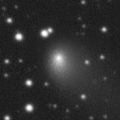
|
Now it is 9.7 mag (Dec. 27, Juan Jose Gonzalez). It is expected to brighten up to 8 mag in 2020. It stays observable in good condition for a long time in the Northern Hemisphere. In the Southern Hemisphere, it is not observable until July.
Date(TT) R.A. (2000) Decl. Delta r Elong. m1 Best Time(A, h)
Dec. 28 3 38.07 54 29.6 1.520 2.331 136 9.4 21:11 (180, 70)
Jan. 4 3 16.25 55 39.3 1.525 2.270 128 9.3 20:22 (180, 69)
|

|
Now it is 11.5 mag (Dec. 27, Juan Jose Gonzalez). It stays bright as 11 mag until January. It stays observable in good condition for a long time in the Northern Hemisphere. In the Southern Hemisphere, it will never be observable again.
Date(TT) R.A. (2000) Decl. Delta r Elong. m1 Best Time(A, h)
Dec. 28 23 30.36 39 33.6 2.918 3.158 94 11.8 18:26 (112, 73)
Jan. 4 23 29.46 39 52.2 3.023 3.168 89 11.9 18:31 (111, 67)
|

|
Now it is 14.5 mag (Dec. 27, Toshihiko Ikemura, Hirohisa Sato).
Date(TT) R.A. (2000) Decl. Delta r Elong. m1 Best Time(A, h)
Dec. 28 0 27.74 12 50.6 5.602 5.783 95 13.5 18:26 ( 15, 67)
Jan. 4 0 29.71 12 53.3 5.715 5.784 89 13.5 18:31 ( 32, 65)
|
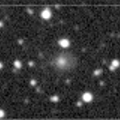
|
Now it is bright as 13.8 mag (Dec. 28, Chris Wyatt). It stays 14 mag until spring. It stays observable for a long time in the Southern Hemisphere. It is not observable until August in the Northern Hemisphere.
Date(TT) R.A. (2000) Decl. Delta r Elong. m1 Best Time(A, h)
Dec. 28 22 5.94 -84 17.6 3.771 3.447 63 14.0 18:26 ( 4,-30)
Jan. 4 23 8.40 -81 40.4 3.774 3.452 63 14.0 18:31 ( 5,-28)
|
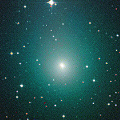
|
It brightened up to 8.3 mag in September (Sept. 20, Maik Meyer). Now it is fading. It has already faded down to 14.9 mag (Dec. 28, Chris Wyatt). In the Southern Hemisphere, it stays observable for a long time after this. In the Northern Hemisphere, it will never be observable again.
Date(TT) R.A. (2000) Decl. Delta r Elong. m1 Best Time(A, h)
Dec. 28 21 57.40 -46 1.2 2.654 2.128 48 14.2 18:26 ( 29, 0)
Jan. 4 22 4.43 -46 21.8 2.784 2.195 44 14.5 18:31 ( 32, -3)
|
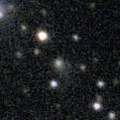
|
Now it is 14.1 mag (Dec. 28, Toshihiko Ikemura, Hirohisa Sato). In the Northern Hemisphere, it is observable at 14 mag in excellent condition in winter. It locates low in the Southern Hemisphere.
Date(TT) R.A. (2000) Decl. Delta r Elong. m1 Best Time(A, h)
Dec. 28 2 38.58 27 22.0 0.773 1.589 129 14.5 20:13 ( 0, 82)
Jan. 4 2 49.82 24 55.9 0.805 1.583 124 14.5 19:57 ( 0, 80)
|
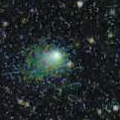
|
Now it is 15.1 mag (Dec. 27, Toshihiko Ikemura, Hirohisa Sato). It will be fading slowly after this.
Date(TT) R.A. (2000) Decl. Delta r Elong. m1 Best Time(A, h)
Dec. 28 22 1.75 -11 45.4 2.285 1.862 52 14.7 18:26 ( 49, 29)
Jan. 4 22 19.79 -10 38.9 2.355 1.882 50 14.8 18:31 ( 52, 27)
|

|
In the Southern Hemisphere, it is observable at 14.5 mag from winter to spring. In the Northern Hemisphere, it is not observable until August when it fades down to 17 mag.
Date(TT) R.A. (2000) Decl. Delta r Elong. m1 Best Time(A, h)
Dec. 28 17 41.36 -67 48.6 2.667 2.091 44 14.8 5:36 (334,-30)
Jan. 4 18 19.11 -70 16.4 2.598 2.069 47 14.7 5:38 (337,-32)
|

|
Now it is 14.6 mag (Dec. 28, Chris Wyatt). It will be fading slowly after this. In the Southern Hemisphere, it becomes low from February to March, but it stays observable for a long time. In the Northern Hemisphere, it is not observasble until summer in 2020.
Date(TT) R.A. (2000) Decl. Delta r Elong. m1 Best Time(A, h)
Dec. 28 22 1.25 -60 45.0 3.859 3.353 52 15.0 18:26 ( 20,-12)
Jan. 4 22 11.11 -58 16.1 3.934 3.380 49 15.1 18:31 ( 24,-11)
|
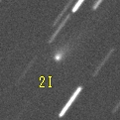
|
Now it is 14.3 mag (Dec. 27, Shigeki Murakami). The orbit is extremely hyperbolic with e=3.35. It is the first interstellar comet in history. It stays 15 mag until January. In the Northern Hemisphere, it will be getting lower after this, and it will be unobservable in mid January. In the Southern Hemisphere, it will be getting higher gradually. Then it will be observable in excellent condition.
Date(TT) R.A. (2000) Decl. Delta r Elong. m1 Best Time(A, h)
Dec. 28 11 59.63 -33 9.5 1.937 2.053 82 15.1 5:36 ( 0, 22)
Jan. 4 12 10.13 -38 12.6 1.943 2.091 84 15.1 5:19 ( 0, 17)
|

|
It brightened up to 7.7 mag in June in 2018 (June 19, Juan Jose Gonzalez). Now it is fading. It has already faded down to 15.1 mag (Nov. 6, Toshihiko Ikemura, Hirohisa Sato). In the Southern Hemisphere, it stays observable for a long time until the comet will fade out. In the Northern Hemisphere, it stays low for a while.
Date(TT) R.A. (2000) Decl. Delta r Elong. m1 Best Time(A, h)
Dec. 28 6 6.53 -33 2.4 4.988 5.591 123 15.2 23:39 ( 0, 22)
Jan. 4 6 0.07 -32 15.8 5.046 5.647 123 15.2 23:05 ( 0, 23)
|
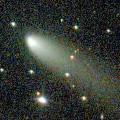
|
It brightened up to 11.4 mag in autumn (Nov. 10, Carlos Labordena). Now it is fading. It has already faded down to 14.8 mag (Dec. 28, Chris Wyatt). It is observable in excellent condition in the Northern Hemisphere. It stays locating extremely low in the Southern Hemisphere.
Date(TT) R.A. (2000) Decl. Delta r Elong. m1 Best Time(A, h)
Dec. 28 2 42.28 44 19.6 1.046 1.842 130 15.2 20:17 (180, 81)
Jan. 4 2 51.09 43 18.6 1.132 1.887 126 15.6 19:58 (180, 82)
|
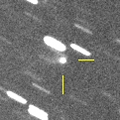
|
Now it is 14.8 mag (Dec. 23, Toshihiko Ikemura, Hirohisa Sato). It stays at 14.5-15 mag until December. It is observable in good condition in the Southern Hemisphere. It locates somewhat low in the Northern Hemisphere.
Date(TT) R.A. (2000) Decl. Delta r Elong. m1 Best Time(A, h)
Dec. 28 22 5.19 -5 48.5 2.163 1.803 55 15.2 18:26 ( 52, 34)
Jan. 4 22 21.05 -3 41.8 2.223 1.813 53 15.4 18:31 ( 58, 33)
|
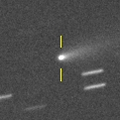
|
Now it is 15.6 mag (Dec. 27, Toshihiko Ikemura, Hirohisa Sato). It is observable at 15 mag in good condition in winter. It locates somewhat low in the Southern Hemisphere.
Date(TT) R.A. (2000) Decl. Delta r Elong. m1 Best Time(A, h)
Dec. 28 11 8.50 11 44.4 1.255 1.862 111 15.3 4:45 ( 0, 67)
Jan. 4 11 16.36 11 41.8 1.217 1.882 117 15.4 4:25 ( 0, 67)
|
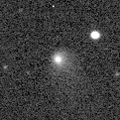
|
Now it is 14.8 mag (Dec. 28, Chris Wyatt). It will be fading slowly after this. In the Southern Hemisphere, it is observable for a long time. It stays low in the Northern Hemisphere.
Date(TT) R.A. (2000) Decl. Delta r Elong. m1 Best Time(A, h)
Dec. 28 23 2.32 -25 37.5 5.194 4.819 62 15.3 18:26 ( 27, 24)
Jan. 4 23 5.84 -24 17.4 5.320 4.853 56 15.4 18:31 ( 34, 22)
|

|
Now it is 15.6 mag (Dec. 28, Toshihiko Ikemura, Hirohisa Sato). It will be fading gradually after this. It will be fainter than 18 mag in April.
Date(TT) R.A. (2000) Decl. Delta r Elong. m1 Best Time(A, h)
Dec. 28 9 38.02 5 20.7 2.129 2.863 130 15.3 3:15 ( 0, 60)
Jan. 4 9 35.23 5 21.8 2.091 2.896 137 15.5 2:45 ( 0, 60)
|

|
Now it is 17.2 mag (Nov. 28, Toshihiko Ikemura, Hirohisa Sato). It will brighten up to 13.5-14 mag from 2020 to 2021. It stays observable in good condition for a long time after this until 2020 summer.
Date(TT) R.A. (2000) Decl. Delta r Elong. m1 Best Time(A, h)
Dec. 28 12 57.83 11 37.2 3.475 3.564 87 15.8 5:36 (327, 63)
Jan. 4 13 2.81 11 36.4 3.358 3.546 92 15.7 5:38 (340, 65)
|
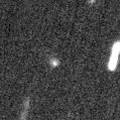
|
Now it is 17.2 mag (Dec. 5, Thomas Lehmann). It will brighten up to 10.5 mag from 2020 December to 2021 January. In the Northern Hemisphere, it stays observable in good condition while the comet will be brightening gradually, but it is not observable at the high light. In the Southern Hemisphere, it is not observable for a long time, but it will be observable in good condition after the high light.
Date(TT) R.A. (2000) Decl. Delta r Elong. m1 Best Time(A, h)
Dec. 28 17 43.97 60 23.4 4.283 4.295 84 16.0 5:36 (215, 32)
Jan. 4 17 51.90 60 20.2 4.216 4.231 84 15.9 5:38 (216, 34)
|

|
It will be fading slowly after this. In the Southern Hemisphere, it stays observable in good condition for a long time, although it becomes low from October to November. It will never be observable after this in the Northern Hemisphere.
Date(TT) R.A. (2000) Decl. Delta r Elong. m1 Best Time(A, h)
Dec. 28 14 31.90 -60 59.9 5.045 4.545 54 16.1 5:36 (342,-11)
Jan. 4 14 32.79 -62 36.9 5.020 4.588 58 16.1 5:38 (346,-11)
|

|
Now it is 16.7 mag (Dec. 10, Thomas Lehmann). It is expected to be observable at 5-6 mag for a long time from 2022 to 2023. In the Northern Hemisphere, it is not observable at the high light from 2022 summer to 2023 summer. In the Southern Hemisphere, it stays unobservable for a while. But it will be observable in good condition at the high light.
Date(TT) R.A. (2000) Decl. Delta r Elong. m1 Best Time(A, h)
Dec. 28 17 47.33 45 25.0 10.455 10.148 69 16.2 5:36 (231, 26)
Jan. 4 17 51.12 45 23.6 10.397 10.100 69 16.1 5:38 (233, 30)
|
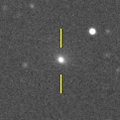
|
Now it is 15.4 mag (Dec. 23, Toshihiko Ikemura, Hirohisa Sato). It stays 15-16 mag until December, and it is observable in good condition.
Date(TT) R.A. (2000) Decl. Delta r Elong. m1 Best Time(A, h)
Dec. 28 0 22.34 -3 32.8 2.167 2.349 88 16.1 18:26 ( 12, 51)
Jan. 4 0 31.39 -2 20.5 2.244 2.346 83 16.2 18:31 ( 21, 51)
|
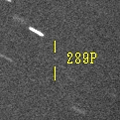
|
It brighted rapidly from 20.5 mag up to 18.5 mag in September. However, the brightness evolution has stopped since October. Now it is very faint as 18.0 mag (Dec. 29, Michael Jager). Michael Jager reported it has a faint coma with a diameter of 50-60 arcsec. It will approaches to Earth down to 0.09 a.u. in early January, and it will brighten up to 15.5 mag. It will be obesrvable in excellent condition in the Northern Hemisphere. In the Southern Hemisphere, it will not be observable at the high light.
Date(TT) R.A. (2000) Decl. Delta r Elong. m1 Best Time(A, h)
Dec. 28 23 11.80 10 27.1 0.133 0.964 77 17.4 18:26 ( 50, 57)
Jan. 4 23 39.00 28 16.5 0.104 0.980 85 16.7 18:31 ( 83, 68)
|
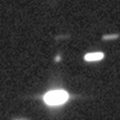
|
It will brighten up to 13 mag in 2021. In 2020, it is observable at 15 mag in good condition from spring to summer.
Date(TT) R.A. (2000) Decl. Delta r Elong. m1 Best Time(A, h)
Dec. 28 14 47.05 -11 21.5 6.435 5.895 52 16.7 5:36 (312, 29)
Jan. 4 14 50.37 -11 57.8 6.295 5.852 59 16.7 5:38 (318, 32)
|

|
Now it is 17.5 mag (Dec. 28, Toshihiko Ikemura, Hirohisa Sato). It stays 16-17 mag for a long time until 2020. It is observable in good condition in the Northern Hemisphere. It is hardly observable in the Southern Hemisphere.
Date(TT) R.A. (2000) Decl. Delta r Elong. m1 Best Time(A, h)
Dec. 28 13 25.92 52 28.6 8.416 8.634 99 16.8 5:36 (215, 67)
Jan. 4 13 28.04 52 47.5 8.364 8.643 103 16.8 5:38 (206, 69)
|

|
Fading. Now it is 17.6 mag (Dec. 27, Toshihiko Ikemura, Hirohisa Sato). It stays 17 mag from autumn to winter. It is observable in good condition in the Northern Hemisphere. It locates low in the Southern Hemisphere.
Date(TT) R.A. (2000) Decl. Delta r Elong. m1 Best Time(A, h)
Dec. 28 8 49.36 23 50.0 5.905 6.751 146 17.0 2:27 ( 0, 79)
Jan. 4 8 43.23 23 53.0 5.889 6.795 155 17.0 1:53 ( 0, 79)
|
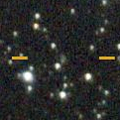
|
Now it is 16.6 mag (Dec. 27, Toshihiko Ikemura, Hirohisa Sato). It will brighten up to 12 mag in winter in 2022.
Date(TT) R.A. (2000) Decl. Delta r Elong. m1 Best Time(A, h)
Dec. 28 22 14.78 40 54.1 7.215 7.170 83 17.3 18:26 (113, 59)
Jan. 4 22 18.68 40 39.8 7.246 7.125 79 17.3 18:31 (113, 53)
|

|
Now it is 17.0 mag (Dec. 27, Toshihiko Ikemura, Hirohisa Sato). It stays bright even after the perihelion passage. It will fade out rapidly after this, and it will be fainter than 18 mag in January. However, it may stay bright for some more time.
Date(TT) R.A. (2000) Decl. Delta r Elong. m1 Best Time(A, h)
Dec. 28 3 8.97 -1 0.9 2.279 2.972 126 17.4 20:43 ( 0, 54)
Jan. 4 3 10.38 -0 28.0 2.407 3.028 120 17.6 20:17 ( 0, 55)
|
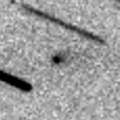
|
Now it is 17.0 mag (Dec. 27, Toshihiko Ikemura, Hirohisa Sato). It is brightening even after the perihelion passage. It will be fainter than 18 mag in January. However, it may stay bright for some more time. It is observable in good condition in the Northern Hemisphere. It locates low in the Southern Hemisphere.
Date(TT) R.A. (2000) Decl. Delta r Elong. m1 Best Time(A, h)
Dec. 28 10 33.73 44 36.9 0.950 1.720 125 17.4 4:10 (180, 81)
Jan. 4 10 42.34 48 1.4 0.952 1.745 128 17.5 3:51 (180, 77)
|

|
Now it is 16.5 mag (Nov. 29, Toshihiko Ikemura, Hirohisa Sato). It will be fading after this, and it will be fainter than 18 mag in January.
Date(TT) R.A. (2000) Decl. Delta r Elong. m1 Best Time(A, h)
Dec. 28 1 5.82 -7 52.0 2.484 2.769 96 17.4 18:40 ( 0, 47)
Jan. 4 0 59.05 -8 17.2 2.668 2.805 87 17.6 18:31 ( 9, 46)
|

|
Now it is 18.4 mag (Dec. 28, Toshihiko Ikemura, Hirohisa Sato). It will brighten very rapidly after this. It will brighten up to 8-9 mag from summer to autumn. It will be observable in excellent condition in the Southern Hemisphere. It locates very low around the high light in the Northern Hemisphere.
Date(TT) R.A. (2000) Decl. Delta r Elong. m1 Best Time(A, h)
Dec. 28 13 4.38 -2 42.9 2.842 2.838 79 17.7 5:36 (335, 49)
Jan. 4 13 11.30 -3 20.0 2.703 2.796 85 17.5 5:38 (343, 50)
|
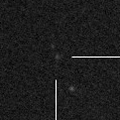
|
Now it is 17.9 mag (Dec. 5, R. L. Flynn). It is observable at 17-18 mag for a long time from late 2019 to early 2021. It will fade out before it passes the perihelion.
Date(TT) R.A. (2000) Decl. Delta r Elong. m1 Best Time(A, h)
Dec. 28 2 53.22 1 20.0 4.473 5.093 124 17.5 20:27 ( 0, 56)
Jan. 4 2 52.06 1 41.0 4.552 5.079 117 17.5 19:58 ( 0, 57)
|

|
Now it is 17.4 mag (Dec. 28, Toshihiko Ikemura, Hirohisa Sato). It stays observable at 16.5 mag for a long time from 2020 to 2021. In the Northern Hemipshere, it is observable in excellent condition for a long time. In the Southern Hemisphere, it is not observable until 2021 summer.
Date(TT) R.A. (2000) Decl. Delta r Elong. m1 Best Time(A, h)
Dec. 28 1 35.01 80 54.7 6.176 6.663 115 17.6 19:09 (180, 44)
Jan. 4 1 17.13 79 31.2 6.189 6.641 113 17.6 18:31 (180, 45)
|
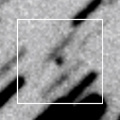
|
Asteroid moving along a comet-like orbit. Now it is 16.5 mag (Dec. 27, Toshihiko Ikemura, Hirohisa Sato). It stays observable at 17 mag from 2020 to 2021. It locates somewhat low in the Northern Hemisphere.
Date(TT) R.A. (2000) Decl. Delta r Elong. m1 Best Time(A, h)
Dec. 28 10 59.17 -24 27.5 6.428 6.638 98 17.7 4:36 ( 0, 30)
Jan. 4 10 59.84 -24 47.0 6.325 6.632 104 17.7 4:09 ( 0, 30)
|
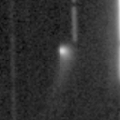
|
Now it is 17.8 mag (Dec. 27, Toshihiko Ikemura, Hirohisa Sato). It will be fading after this. In the Northern Hemisphere, it stays observable in good condition for a long time. In the Southern Hemisphere, it stays extremely low for a long time.
Date(TT) R.A. (2000) Decl. Delta r Elong. m1 Best Time(A, h)
Dec. 28 0 59.08 28 14.6 4.178 4.578 107 17.7 18:33 ( 0, 83)
Jan. 4 0 57.15 26 48.5 4.340 4.620 100 17.8 18:31 ( 37, 80)
|

|
Now it is 17.5 mag (Dec. 4, Toshihiko Ikemura, Hirohisa Sato). It will be fainter than 18 mag in 2020 spring.
Date(TT) R.A. (2000) Decl. Delta r Elong. m1 Best Time(A, h)
Dec. 28 12 42.47 6 57.0 10.593 10.617 88 17.8 5:36 (338, 60)
Jan. 4 12 43.62 7 5.2 10.494 10.633 95 17.8 5:38 (352, 62)
|

|
Fading now. Now it is 16.3 mag (Dec. 26, Martin Masek). In the Southern Hemisphere, it stays observable for a long time until it fades out. In the Northern Hemisphere, it will not be observable after this.
Date(TT) R.A. (2000) Decl. Delta r Elong. m1 Best Time(A, h)
Dec. 28 5 1.19 -55 55.7 5.472 5.706 98 17.8 22:33 ( 0, -1)
Jan. 4 4 50.75 -55 43.1 5.553 5.758 97 17.9 21:55 ( 0, -1)
|
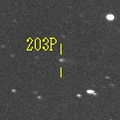
|
Now it is 16.5 mag (Dec. 28, Toshihiko Ikemura, Hirohisa Sato). It is observable at 17 mag in good condition in winter. It locates somewhat low in the Southern Hemisphere.
Date(TT) R.A. (2000) Decl. Delta r Elong. m1 Best Time(A, h)
Dec. 28 3 58.18 23 4.7 2.355 3.221 146 17.8 21:32 ( 0, 78)
Jan. 4 3 55.99 22 50.0 2.411 3.216 138 17.8 21:02 ( 0, 78)
|

|
It brightened up to 14 mag from autumn to winter in 2018. Now it is fading. It is observable at 17.5 mag in good condition from winter to spring.
Date(TT) R.A. (2000) Decl. Delta r Elong. m1 Best Time(A, h)
Dec. 28 13 42.66 -0 55.6 4.334 4.133 71 17.8 5:36 (321, 47)
Jan. 4 13 45.27 -1 25.7 4.266 4.175 78 17.8 5:38 (330, 49)
|

|
Now it is 17.8 mag (Dec. 28, Toshihiko Ikemura, Hirohisa Sato). It will brighten up to 16 mag in March, and it will be observable in good condition.
Date(TT) R.A. (2000) Decl. Delta r Elong. m1 Best Time(A, h)
Dec. 28 11 48.71 43 59.4 1.393 1.986 112 18.0 5:25 (180, 81)
Jan. 4 11 55.10 44 0.1 1.307 1.953 116 17.8 5:04 (180, 81)
|
|
![]()
 173P/Mueller 5
173P/Mueller 5 C/2019 T3 ( ATLAS )
C/2019 T3 ( ATLAS ) A/2019 C1
A/2019 C1 C/2018 A3 ( ATLAS )
C/2018 A3 ( ATLAS ) C/2014 B1 ( Schwartz )
C/2014 B1 ( Schwartz ) C/2016 N6 ( PanSTARRS )
C/2016 N6 ( PanSTARRS ) 203P/Korlevic
203P/Korlevic (944) Hidalgo
(944) Hidalgo 124P/Mrkos
124P/Mrkos![]()



































